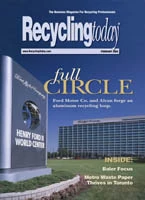A BURNING QUESTION
In the question and answer period of a recent New England Chapter meeting of the Construction Materials Recycling Association (CMRA), representatives from five state regulatory agencies were asked why wood fuel made from C&D is not always considered a form of recycling.
"Isn’t it better that it goes up a smokestack in Maine as CO2 than to come back to us from Ohio in the form of methane?" was the gist of a question asked by a member of the audience. Two regulators did not respond. Of the three who did, Chris Way of the New Hampshire Department of Environmental Services (NHDES) said that changing burning of C&D wood for fuel to a recycling status had come up in agency discussions, but agency decision-makers have not thus far changed the definition. He urged recyclers to become involved to promote the change.
Connecticut has had similar discussions, but climate change issues are coming to the forefront at the Connecticut Department of Environmental Protection (DEP), said the agency’s Frank Gagliardo. He was unsure whether the state’s view would ever change to consider burning the chips as recycling.
James McQuade of the Massachusetts DEP admitted that combustion is not considered recycling because of an association with the burning of MSW. If the agency were to allow C&D wood fuel to be considered recycling, he said, then it would have to consider MSW burning as recycling, and no one was ready to do that. But DEP is considering the burning of wood brush as recycling, and if that were to happen, perhaps the definition could be expanded to include all wood.
Representatives in attendance from Vermont and Maine did not comment on the situation. Absent from the meeting was the Rhode Island Department of Environmental Management. The agency said its employees were too busy to attend, according to CMRA executive directory William Turley. Recyclers were disappointed not to hear from the agency in a state where two prominent developments have taken place.
The recent demise of independent recycler N.E.E.D. has changed the C&D picture in Rhode Island. Also in that state, the quasi-governmental state landfill, which handles a large majority of the state’s waste, has a contract with Recovermat to make alternative daily landfill cover at the site.
The regulators’ presentations were preceded by a report on the C&D-derived fuel market in New England by Leo Larochelle of CMRA member ERRCO, Epping, N.H. He also provided information on the characteristics of C&D wood.
The entire meeting was organized by John Blaisdell and Greg Wirsen of Green Seal Environmental, leaders of the New England Chapter.
HOPE FOR LBP DEBRIS?
Two companies have demonstrated what they call a portable wood "de-leading and recovery system" at the Fort Ord demolition project in Monterey, Calif.
A self-contained system has been designed by Auburn Enterprises LLC, Lewiston, Maine, and Wood Waste Diversion Inc., Pacific Grove, Calif., to remove coatings on recyclable, de-constructed wood materials covered with lead-based paint (LBP)—even pieces with embedded nails.
According to the companies, the system has the potential to significantly reduce the amount of painted wood that would be destined for municipal and hazardous waste landfills.
The demonstration project focused on converting #105 drop siding coated with multiple layers of lead-based paint into clean lumber. In a single pass through a de-leading system trailer, nearly 8,000 linear feet of old military barracks siding was broken down into two products: 1) shavings and sawdust with paint residue and 2) boards sized and ready for conversion into a wide range of value added recycled wood products. The process reduced the volume of solid waste material by more than 50 percent.
The demonstration was made possible with support from the U.S. Army Engineer Research & Development Center and its Construction Engineering Research Lab (ERDC/CERL) in Champaign, Ill.; plus the USDA Forest Products Laboratory in Madison, Wisc.; and Concurrent Technologies Corp., Largo, Fla.
MIXED C&D MARKETS PINCHED IN VEGAS
Recyclers of mixed C&D materials in the Las Vegas area are now under strict rules that severely limit the materials they can process. The stringent limits may force some recyclers out of business unless they revise their operating methods.
Under recycling center regulations recently implemented by the Clark County (Nev.) Board of Health, recycling centers may only accept source-separated materials with an "insubstantial amount" of non-recyclables in the load. Commingled C&D waste is no longer acceptable for processing. Reportedly, facilities that have continued to take in mixed C&D have faced administrative hearings, with one recycler penalized with a fine.
Certain facilities that qualify under separate MRF regulations are apparently exempt from the regulations. According to one Las Vegas recycler, "The way those regs are written, only the city, county and Republic Industries and its agents qualify [for the exemption]."
According to William Turley, executive director of the Construction Materials Recycling Association, Lisle, Ill., less than two years ago, Republic Industries bought Silver State Disposal, operators of a landfill in Las Vegas. Many competing recyclers believe the company worked with Clark County officials and politicians to fashion the MRF and recycling center regulations in their favor. Recycling advocates say the Republic/Silver State operation concentrates far more on landfilling as opposed to recycling.

Explore the February 2003 Issue
Check out more from this issue and find your next story to read.
Latest from Recycling Today
- Nextek, Coveris to recycle food-grade plastic film
- Recyclekaro expands recycling capacity
- USTR hears comments on port fee proposal
- C&D World 2025 hits record attendance and exhibitor numbers
- Denali now offers mobile depackaging service
- Hyundai confirms Louisiana as EAF mill site
- ASCE sees infrastructure progress, but more to be done
- Global steel output tapers downward






